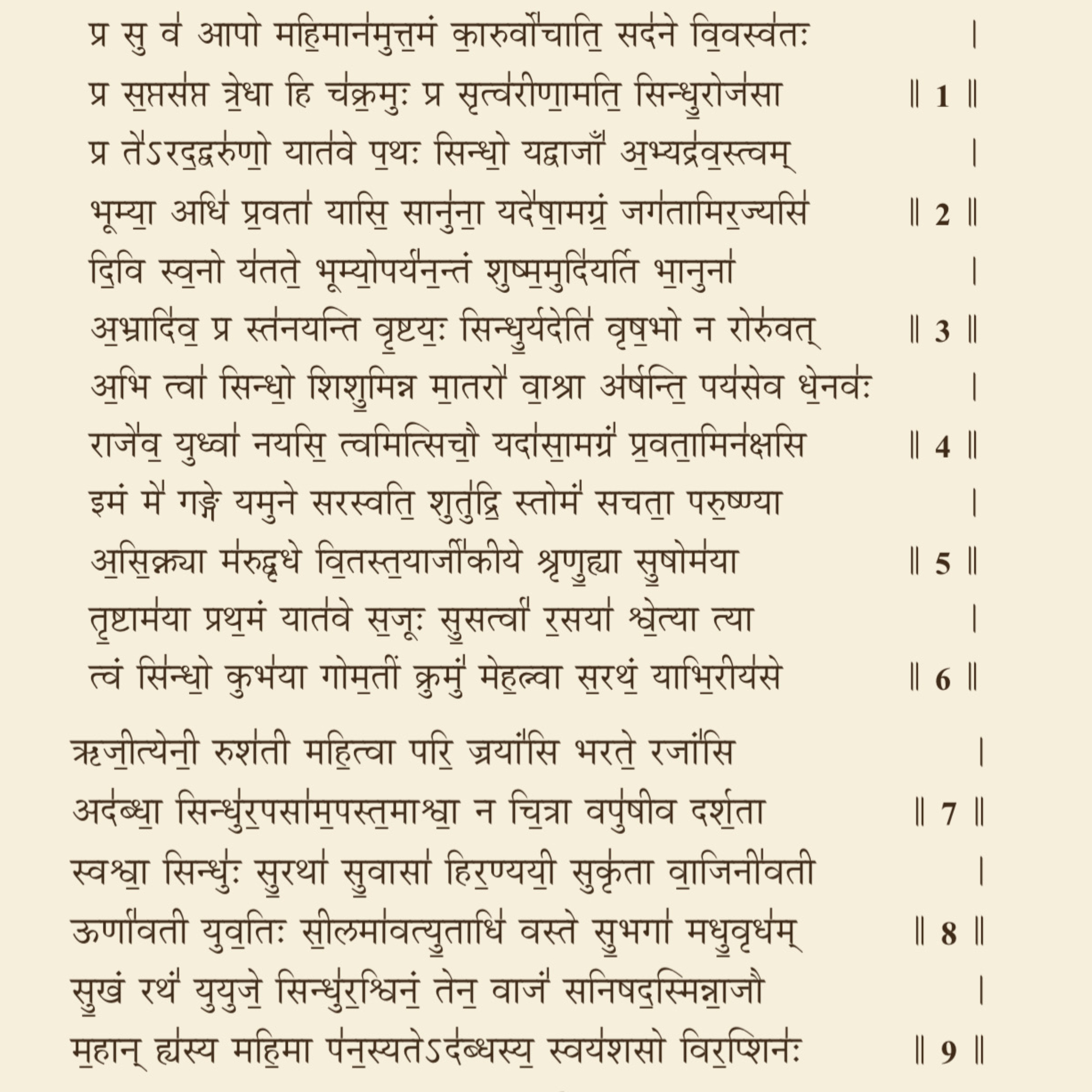Nadistuti on:
[Wikipedia]
[Google]
[Amazon]
 The Nadistuti sukta (Sanskrit: नदिस्तुति सूक्त), or "the hymn in praise of
The Nadistuti sukta (Sanskrit: नदिस्तुति सूक्त), or "the hymn in praise of
The Geography of the Rigveda
{{Rigveda Rigveda Vedic hymns
 The Nadistuti sukta (Sanskrit: नदिस्तुति सूक्त), or "the hymn in praise of
The Nadistuti sukta (Sanskrit: नदिस्तुति सूक्त), or "the hymn in praise of river
A river is a natural flowing watercourse, usually freshwater, flowing towards an ocean, sea, lake or another river. In some cases, a river flows into the ground and becomes dry at the end of its course without reaching another body of w ...
s", is 75th hymn (''sukta'') of 10th MandalaTogether with 1st Mandala, 10th Mandala forms the latest part of the Rigveda of the Rigveda
The ''Rigveda'' or ''Rig Veda'' ( ', from ' "praise" and ' "knowledge") is an ancient Indian collection of Vedic Sanskrit hymns (''sūktas''). It is one of the four sacred canonical Hindu texts ('' śruti'') known as the Vedas. Only one ...
.
Nadistuti sukta is important for the reconstruction of the geography of the Vedic civilization. Sindhu
The Indus ( ) is a transboundary river of Asia and a trans-Himalayan river of South and Central Asia. The river rises in mountain springs northeast of Mount Kailash in Western Tibet, flows northwest through the disputed region of Kashmir, ...
(the Indus) is addressed as the mightiest of rivers and addressed specifically in verses 1, 2, 7, 8 and 9.
The rivers
In verse 5, the rishi enumerates ten rivers, beginning with the Ganga and moving westwards: # Ganga #Yamuna
The Yamuna ( Hindustani: ), also spelt Jumna, is the second-largest tributary river of the Ganges by discharge and the longest tributary in India. Originating from the Yamunotri Glacier at a height of about on the southwestern slopes of B ...
# Sarasvati
# Sutudri
# Parusni
# Asikni
#Marudvrdha
#Vitasta
The Jhelum River (/dʒʰeːləm/) is a river in the northern Indian subcontinent. It originates at Verinag and flows through the Indian administered territory of Jammu and Kashmir, to the Pakistani-administered territory of Kashmir, and ...
# Arjikiya
# Susoma
Verse 6 adds northwestern rivers (tributaries of the Indus flowing through Afghanistan and north-western Pakistan),
Griffith translates:
"First united with the Trishtama in order to flow, with the Susartu and
Rasa, and with this Svetya (you flow), O Sindhu (Indus) with the Kubha
(Kabul R.) to the Gomati (Gomal), with the Mehatnu to the
Krumu (Kurram), with whom you rush together on the same chariot."
# Trstama
# Susartu
#Rasā
Rasa (' ) is the name of a western tributary of the Indus in the Rigveda (verse 5.53.9). The word rasa means "moisture, humidity" in Vedic Sanskrit.
In RV 9.41.6, RV 10.108 and in the Nirukta of Yaska, it is the name of a mythical stream suppos ...
# Shvetya
#Sindhu
The Indus ( ) is a transboundary river of Asia and a trans-Himalayan river of South and Central Asia. The river rises in mountain springs northeast of Mount Kailash in Western Tibet, flows northwest through the disputed region of Kashmir, ...
# Kubha
# Gomati
# Krumu
# Mehatnu
According to Max Mueller on 10.75.5 in the book ''India: What Can It Teach Us?'' :
"Satadru (Sutlej)". "Parushni (Iravati, Ravi)". "Asikni, which means black". "It is the modern Chinab". " Marudvridha, a general name for river. According to Roth the combined course of the Akesines and Hydaspes". Vitasta, the last of the rivers of the Punjab, changed in Greek into Hydaspes"."It is the modern Behat or Jilam". "According to Yaska the Arjikiya is the Vipas". "Its modern name is Bias or Bejah". "According to Yaska the Sushoma is the Indus".
References
External links
The Geography of the Rigveda
{{Rigveda Rigveda Vedic hymns